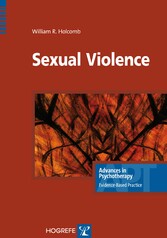
Sexual Violence
von: Bill Holcomb
Hogrefe Publishing, 2010
ISBN: 9781616763336
Sprache: Englisch
102 Seiten, Download: 736 KB
Format: PDF, auch als Online-Lesen
2.2 A Comprehensive Model of Prediction
A weakness in the development of the HMC model, according to Knight and Sims-Knight (2003), is that the testing of the model did not include good measures of developmental antecedents or delinquency. Knight and Sims-Knight (2003) have used the Multidimensional Assessment of Sex and Aggression (Knight, Prentky, & Cerce, 1994) with different populations of criminals, noncriminals, and juveniles to test Malamuth’s model. They propose that prediction of violent sexual behavior by three paths better accounts for sexual aggression compared to the two paths in the HMC model. These three paths could be described as:
1. Sexual drive/preoccupation;
2. Antisocial behavior;
3. Callousness/unemotionality.
The major contribution of this modal is the further clarification of early child antecedents of these three paths. In this model, physical /verbal abuse contributes directly to antisocial behavior and to callousness/unemotional responsiveness that indirectly also contributes to antisocial behavior, which then leads to sexual coercion. Sexual abuse in childhood has a separate influence on sexual coercion through sexual fantasies and aggressive sexual fantasies (the sexual drive/preoccupation path). Sexual abuse in childhood becomes more salient as a precursor of sexual preoccupation if certain sexual abuse factors are present in the coercive person’s early history. These factors include degree of penetration, amount of coercive force, number of perpetrators, and age of sexual abuse.
2.3 An Integrated Theory of Sexual Offending
One more comprehensive theory of sexual coercion is important to mention. Ward and Beech (2008) have described their Integrated Theory of Sexual Offending (ITSO). This theory proposes a network of causal factors including biological, ecological, and basic core neuropsychological systems. The biological influences include genetics and evolutionary mechanisms. The ecological niche factors involve social learning influences from cultural and personal circumstances, and the physical environment. Neuropsychological functioning is a third factor that influences motivation and emotions, behavioral controls, action selection, and perception, and memory. Thus, genetics, social learning, and neuropsychological functioning all interact to lead to sexual offending with accompanying, deviant arousal, offense-related thoughts and fantasies, negative or positive emotional states, and social difficulties.
The social learning experiences of the sexually coercive individual are of special interest. Ward and Beech (2008) refers to this component as the ecological niche. The ecological niche of a person is the set of potentially adverse personal circumstances, cultural influences, and physical environments that the person experiences. The psychological system of the person is set by these biological and social learning experiences. Ward and Beech (2008) describe both distal and proximal influences. Once psychological vulnerabilities are acquired, the person will have the propensity not to cope well with environmental stresses. For example, the effects of childhood sexual abuse can lead to psychological disorders and alcohol and substance abuse. In addition, the long-term effects of sexual victimization can include disturbed adult sexual functioning, poor social adjustment, confusion over sexual identity, and inappropriate attempts to reassert masculinity with the potential for abusing others. Also, the experience of war can contribute to the diminution of behavioral controls (Henry, Ward, & Hirshberg, 2004).
At the heart of this theory is the recognition of the importance of neuropsychological functioning. The neuropsychological functioning of a person has direct influence on motivational/emotional responses, action selection, control systems, and perception and memory. Some of the dynamic variables that have been linked to sexual offending are seen as difficulties of motivation/emotion expression that are controlled by the cortical, limbic, and brainstem structures of the brain. For example, someone brought up in an impoverished environment may have difficulties identifying his emotions and the emotions of others, especially in stressful situations. This may contribute to the development of antisocial or aggressive behavior. This person may also not have developed the social skills necessary to establish strong interpersonal relationships, and as a result may have significant intimacy skills and attachment problems. Behavioral controls and action selection are associated with the functioning of the frontal cortex, the basal ganglia, and parts of the thalamus. Characteristics seen with sex offenders could be seen as deficits in selfmanagement and self-regulation that are influenced by these brain structures. Some of these deficits include impulsivity, failure to control the expression of negative emotions, not being flexible with adjusting plans based on changing circumstances, and poor problem-solving skills.
Other important areas of perception and memory are influenced by the hippocampal formation and the posterior neocortex. Disturbances in memory and perception can lead to maladaptive cognitions and beliefs and inappropriate interpretation of social interactions. These faulty perceptions and distorted memories can then serve as filters of social information. Some researchers have identified stable dynamic indicators such as cognitive distortions as precursors of sexual offending (Hanson & Harris, 2000; Thornton, 2002).
2.4 A Theory of Interacting Proximal and Distal Predictive Factors
It appears that Ward and Beech’s theory (2008) is built on the early theorizing of Marshall and Barbaree (1990). In this modal, sexual abuse of children occurs because of the interacting of proximal and distal factors. Adverse happenings in early childhood have an important influence on later sex offending. These adverse advents include poor parenting, inconsistent and harsh discipline, and physical and sexual abuse. These adverse events lead to distorted internal psychological modals used by the person. These distortions lead to inadequate understanding of relationships, especially with regard to sex and aggression, which in turn leads to poor social and self-management skills very early in life. For these persons, adolescence is an especially important transition time. During this time, they are most receptive to acquiring enduring preferences, interests, and attitudes. The increase in sex hormones at this time supports the establishment and importance of sexually related thinking patterns. Marshall and Barbaree (1990) speculate that the pubertal release of hormones may contribute to the fusing of sex and aggression at this critical age.
Ineffective social and self-management skills lead to ineffective attempts at relationships with women that contribute to low self-esteem, anger, and negative attitudes towards women. These intense negative emotions may enhance the potency of sexual desires and even deviant sexual fantasies to achieve what they cannot with their inadequate skills. Compulsive and frequent masturbation can reward mental rehearsal of deviant fantasies. These fantasies, rewarded frequently with masturbation, come to replace important skills of interpersonal closeness, self-esteem, and healthy masculinity.
These vulnerability and more distal factors then interact with more proximal factors and lead to sex offending. Some of these more proximal factors can include stress, intoxication, strong negative affect, sexual stimuli, and the availability of a victim. The sexually coercive behavior in combination with cognitive distortions is thus reinforced in a positive way through sexual arousal and sense of power, and in a negative way through the reduction of low mood.
Clearly, the theory of Ward and Beech (2008) and the earlier theory of Marshall and Barbaree (1990) integrate many factors that can explain the different paths taken to assault victims. These theories are different from those of Malamuth (2003) and Knight and Sims-Knight (2003); for example, they involve a higher level of abstraction and are not based on statistical modeling.
When examined together the modals of sexually offending based on statistical modeling provide important detailed information based on reliable measuring instruments that help define the more general vulnerability factors in the broader theoretical models. For example, the more specific concepts of hostility toward women, the acceptance of rigid masculine roles, and acceptance of aggression are specific concepts that can help us understand the broader concept of anger. Refining these concepts can be helpful in understanding more clearly the schemas of offenders and how to therapeutically address their cognitive distortions. Thus, both the broader and more abstract theories and those based on statistical modeling do contribute to our understanding of sexual coercion.








